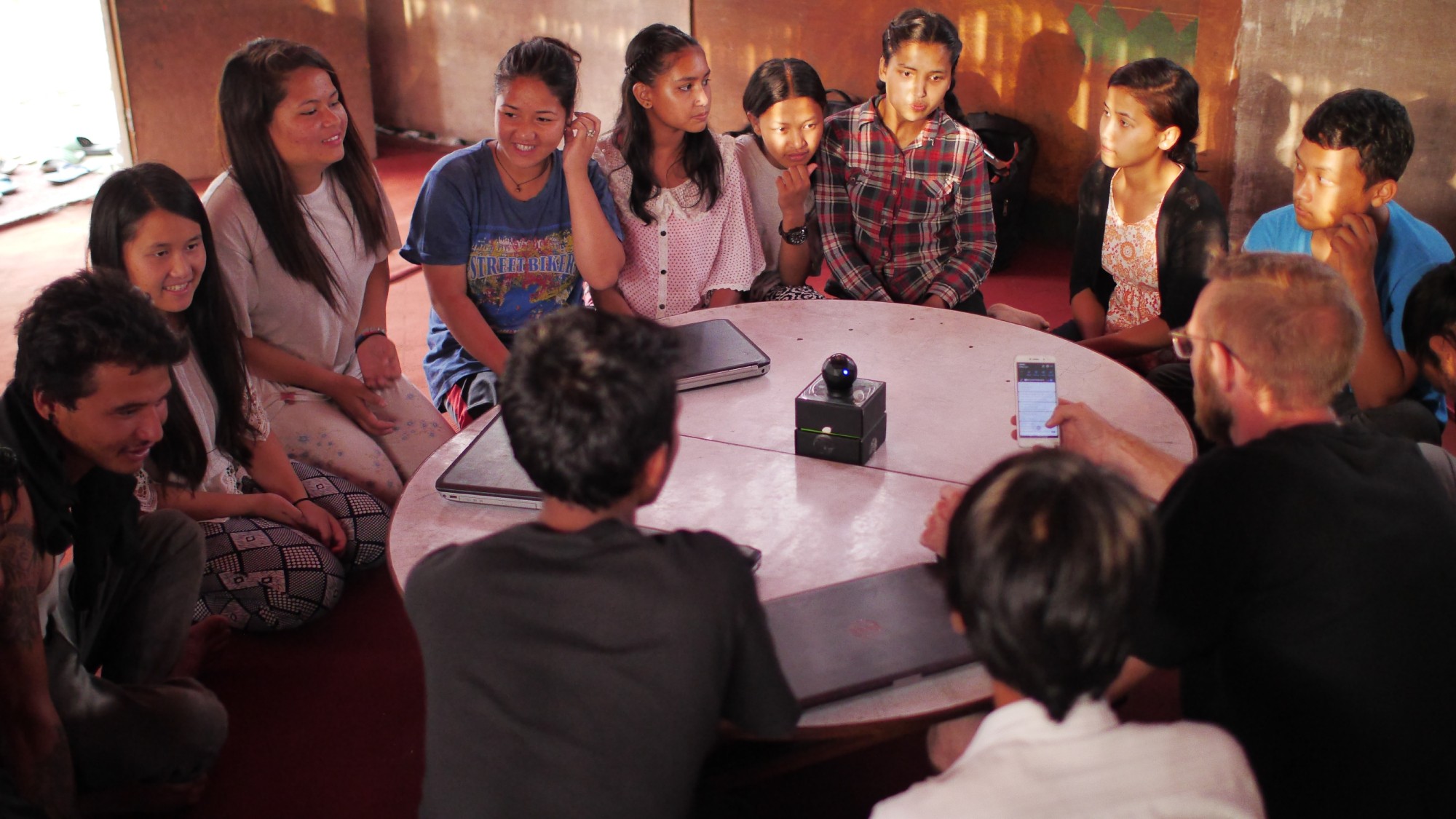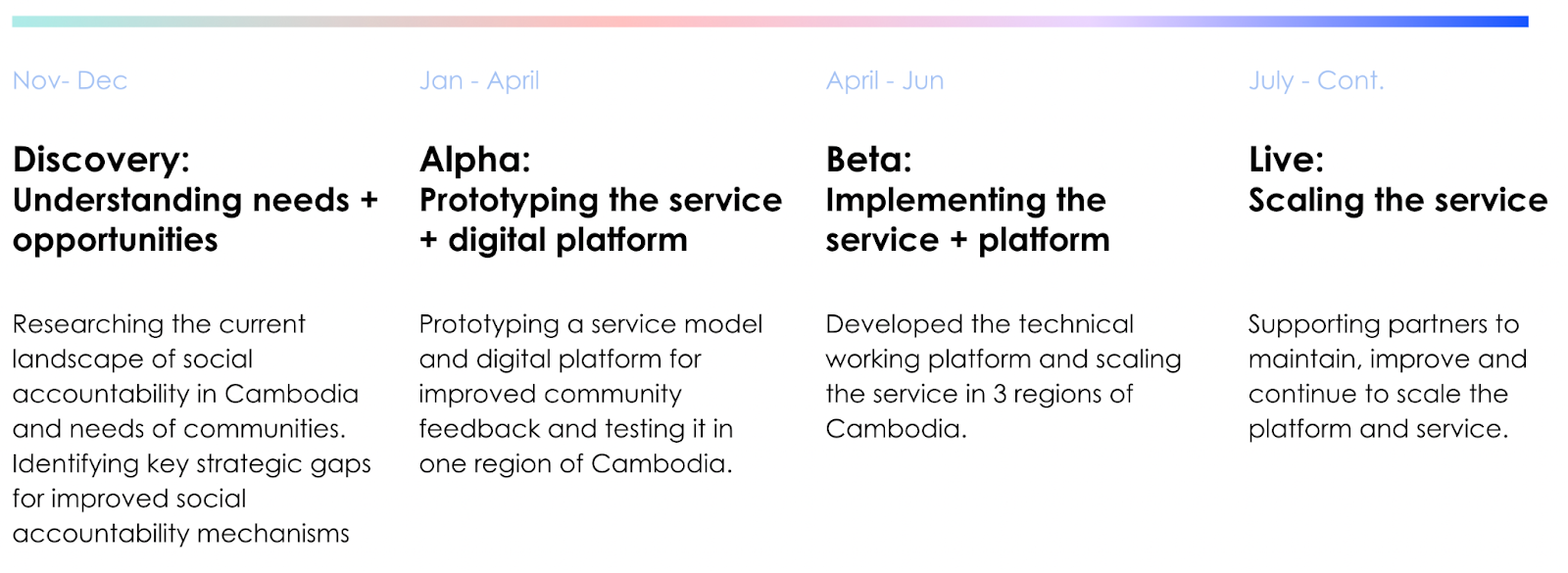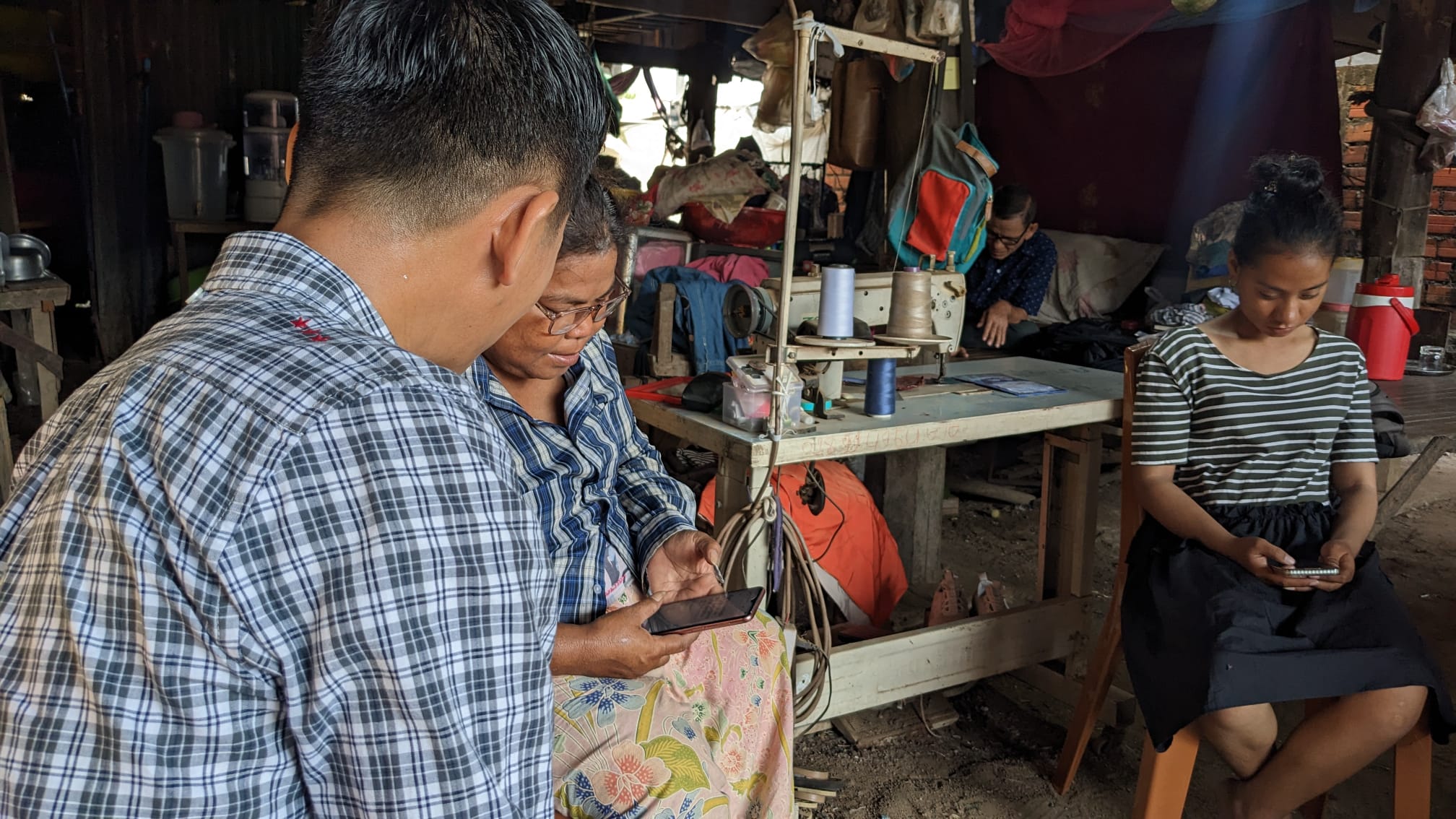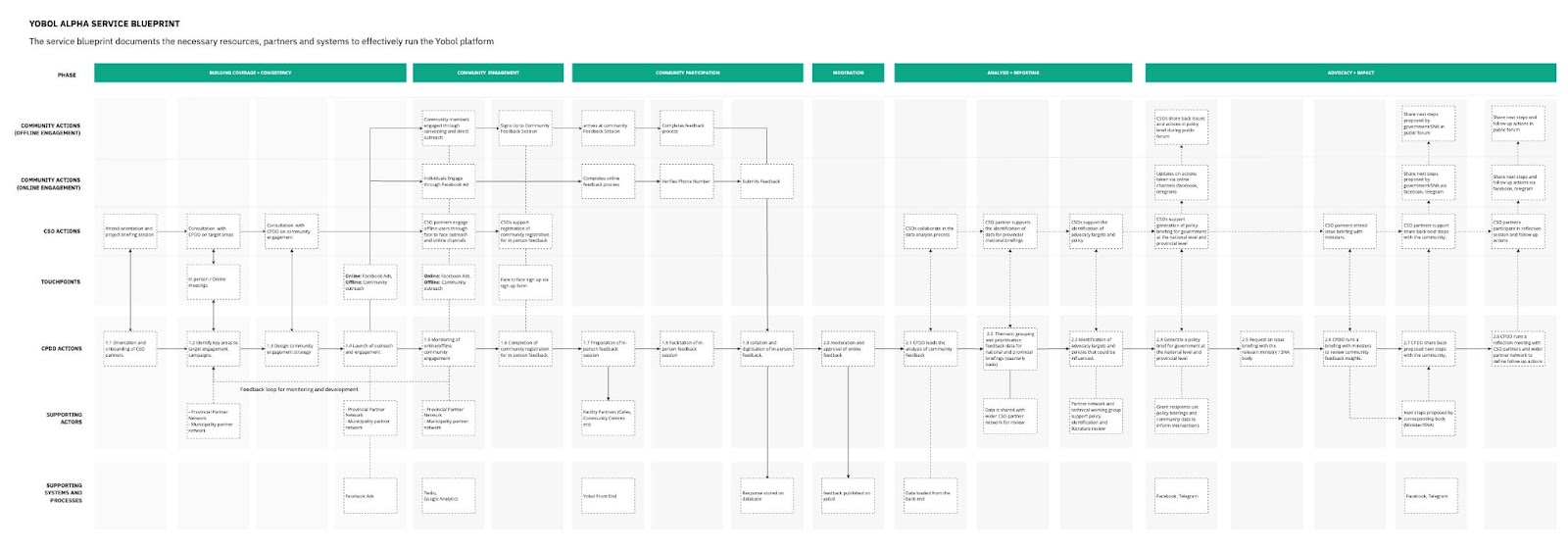Revolutionising how communities participate in public sector services in Cambodia
Working with UNDP Cambodia to enable communities to have a voice in the delivery of public services, creating grassroots mechanisms for improved communication between government and the people.
Nesta for UNDP Cambodia

Project Overview
At Nesta I have been leading a partnership with the UNDP Cambodia and the Coalition for Democratic Development (CPDD) to develop a new service and digital platform to support community feedback, working towards building a culture of feedback that enables communities to have their voices heard, enables CSOs to effectively advocate on behalf of communities and ultimately results in better public services.
Our Theory of Change: Developing a culture of feedback and participation

Our Approach
Basing our approach on the government service standard, we designed and implemented the service over 10 months. Our approach included conducting an in-depth discovery into current social accountability initiatives and community needs, prototyping new service models, and finally launching the service to 3 regions within Cambodia reaching over 260,000 people.

Discovery: Understanding the landscape of social accountability, community needs and identifying opportunities to improve public service feedback.
During Discovery we worked closely with our partner CPDD and communities to understand how they currently use and give feedback to public services, barriers faced, and opportunities to improve the feedback process. This phase focused on 3 key research objectives:
01. Understanding current feedback mechanisms: Understanding how people currently give feedback on public services and their experiences.
02. Existing Barriers to Feedback: Identifying barriers to giving feedback and opportunities to improve feedback mechanisms.
03. Digital Literacy and Technology Usage: Understand the digital literacy + technology behaviours of different groups.
Discovery - Key Insights
Our research uncovered several key insights into the existing cultural landscape of public service feedback and identified several key barriers to participation.
Lack of Trust in Institutional Processes
Through our research we learned that communities don’t always trust the government to provide safe ways for communities to feedback without repercussions, nor do they believe the government will act on feedback received from individuals. Communities indicated that there is greater willingness to trust CSOs and NGOs to interface with the government on their behalf.
Absence of community indicators on what is considered good service
The current methodology for assessing public services is driven by demand side indicators and does not take into account community perspectives. When interviewing communities on what is most important they identified that friendliness, speed, cost and if they were asked to pay an additional fee were key considerations when using a service.
Data transparency and accessibility
Communities and third parties such as CSOs face challenges in accessing reliable information and data on public service performance. Current data collected around public service performance is very difficult to access and often ‘black boxed’ with poor provenance on how the data was collected. This represents a key challenge when advocating for change and service improvement as reliable data on service quality isn’t accessible.
“Even though there is a political mandate from the top levels of government to improve public service there is never any visible change on the ground.” - Quote from a community member summarised in english
Identified participation barriers faced by communities
Bottlenecks in current accountability programmes:
Although there are emerging social accountability initiatives from several international development organisations that focus on community feedback, many are hindered by feedback bottlenecks when soliciting responses from communities. People often have to wait in long queues during moderated feedback sessions for a facilitator to enter their feedback into a dedicated device leading to high wait times and frustration when engaged to participate.
Existing feedback mechanisms often indirectly excluded marginalised groups:
Throughout our research various groups of people from young mothers with caring responsibilities, women with irregular working schedules and people with disabilities indicated that current feedback events were difficult for them to attend because the timings were often in conflict with their other responsibilities or some where directly discouraged from participating.Therefore, a key challenge for us to address within our service design process was to create a service that was inclusive to all and allowed for easy and flexible engagement from communities.
Varying levels of literacy/digital literacy across the population:
Digital literacy and literacy barriers were also a key barrier to solve when designing an inclusive feedback service. While the literacy rate is around 90% of urban populations in Cambodia, rural communities face literacy challenges with an estimated 74% literacy rate. Gender also plays a factor in literacy rates with an 85.1% literacy rate amongst men and 71% amongst women.1 This gap is often wider with indigenous communities and marginalised groups. During our research we found that while interviewing and observing people on their technology behaviours younger people (16-25) were much more comfortable using digital tools, whereas adult women (30-55) and people with disabilities often faced challenges.

Using the UK government digital literacy scale we scored citizens technical literacy and likelihood to adopt online services.
Design Opportunities: key strategies to improve public service feedback
Reviewing the barriers faced by communities we identified the following strategic opportunities to improve public service feedback and create a service that is inclusive of different members of society.
Community driven service quality indicators:
Using ‘demand side’ community based indicators more accurately represents what is important to communities when considering public service quality. Our initial research indicated that speed, friendliness, cost and if they were asked to pay a bribe were the indicators that most mattered to people. During Alpha we planned to test these indicators and validate with a wider group of people.
A quick and easy digital service:
Addressing the current bottlenecks with moderated digital participation we identified a strategic opportunity for a quick and easy to use digital service that offers flexible engagement for communities. Additionally, our research has shown that the need to be available at key times and attend feedback events is a key barrier to participation. By providing a digital service that is simple, quick and easy to use, communities can provide their feedback without facing unnecessary barriers.
Inclusive in-person feedback mechanisms built into the service model:
Alongside the opportunity to create a quick and simple digital service our research indicated that this would not be inclusive or the best approach for diverse participation without a mechanism for in-person feedback. Therefore a key design consideration for piloting our service was to design and test in person sessions that enabled people with digital accessibility issues or simply those who wished to participate in person a way to express their views.
Alpha: Prototyping a service and digital platform to enable local community feedback on public services.
Focusing on healthcare services, during Alpha we worked with our local partner CPDD to design a new service model and digital platform enabling the organisation to collect feedback from communities and utilise the data with partner CSOs to advocate for public service improvement and reform. For the Alpha phase we focused on on the following objectives:
01. Design and evaluate a new service model to enable community feedback on healthcare services.
02. Understand the data needs of CSOs and how they can integrate data into existing advocacy efforts.
03. Test the usability of the platform with respective communities to understand issues and improvements.

Community testing session during the Alpha Phase
Testing the platform and service
During the Alpha phase we ran usability testing sessions and piloted the digital platform and service in our target region of Kampong Cham, evaluating the viability of the service model and platform. At the beginning of the phase we ran a series of sprints to design and test a minimal viable product of the digital feedback process, getting feedback from communities. This enabled us to test the usability and identify improvements in language, tone and accessibility, along with optimising the application for limited internet connectivity.
“Once you get set up it's very simple and quick to give feedback.” - Quote from a Community member summarised in english
Piloting the Service
After the completion of several design iterations we ran a short pilot to evaluate the service model and platform in a real world context with real users. Over the duration of one week we delivered the service live to communities in Kampong Cham, testing the viability of the service model and delivery of the digital platform in a live environment.
Determining cost and viability of the service model
To better understand the viability of the service as it continues to scale to other regions in Cambodia we completed cost modelling to estimate the staffing cost of growing and scaling the model over multiple areas and with a higher volume of users. By analysing what effort, skills and staff were needed to deliver the service we learned what necessary skills and resourcing would be necessary to scale the platform throughout subsequent stages of service development and the resources necessary to sustain the solution towards national coverage.

Service Blueprint tested during the Alpha Phase
Testing different forms of engagement
Testing out strategies to define the right channels and mediums for reaching communities was a key part of understanding how people would like to engage. Using a hybrid approach we tested both online engagement and traditional in-person engagement throughout the duration of the pilot. The results were surprising. Despite achieving a large reach through facebook, online engagement produced a limited number of feedback reviews. Grassroots in-person outreach proved more effective at convincing people to provide feedback but conversely was limited in reach. Therefore, online strategies were best placed at building awareness over time whereas direct engagement was more beneficial for encouraging feedback at nascent stages of service development.
Engaging with local CSOs to deliver the service
Working closely with grassroots CSO partners to deliver the service we were also able to get an in-depth understanding of their data needs to inform advocacy activities. Throughout the two weeks we held numerous workshops with partners to identify community engagement strategies, data needs and how they could potentially partner to support the delivery of the service in different regions.
Beta: Scaling the platform and service to 3 regions
During Beta we partnered with local grassroots CSOs to scale up our service pilot to 3 regions and ran a range of online and in-person community engagement activities to increase awareness, participation and collect feedback from the community participating in giving public healthcare feedback on where the service can improve. For this phase we focused on two key objectives:
01. Scaling Deployment: Scale the service and platform deployment to 3 regions of Cambodia
02. Testing at Scale: Evaluate the platform at scale with a greater number of users

Snapshot of visitors to the service feedback platform during Beta testing
During our Beta testing a total of 391 people used the service to give feedback on their experiences with public healthcare and 262,592 visited the online platform to learn more about the service. Our analysis of traffic shows that mostly younger people aged 18-35 visited the platform to learn more about the service, supporting the need for an accessible digital mechanism for younger people, but also reinforcing the need for alternative mechanisms such as in person outreach and feedback activities to reach demographics that aren't as digitally active.
Live: Continuing to scale and build capacity
As the service moves to the live phase we are continuing to support our partners to sustain and grow the service and platform to reach national coverage and expand to further public services areas such as education and administration. Scaling the service into live we have been exploring sustainable financing options, building partnerships with grassroots CSOs and focusing on the long term vision for the service.
What we have learned
Change happens at the speed of trust:
While you could design the best service imaginable, often the intangible and relational aspects of design for cultural change can only happen at the speed of trust. While we made strides to develop our service, building trusting relationships with communities and laying the foundations for social change is a much longer term commitment which needs to be cultivated over time.
Designing for diverse needs requires diverse solutions:
In an age where digital solutions are front and centre a much more nuanced approach is needed to design truly inclusive solutions. Despite a high smartphone adoption rate in Cambodia we found a need to provide other ways to engage and a strong tradition of grassroots community feedback that proved a valuable addition to a digital only approach.
Building cross sector relationships is a key part of systems change:
Through our engagement with local partners, grassroots CSOs, International NGOs and government stakeholders we learned that in order to build and sustain effective approaches to social change projects it’s necessary to convene and collaborate with a wide range of stakeholders who each have their part to play in stewarding more equitable futures.
- 01. Cambodia Facing Ongoing Literacy Challenges. Available at: https://www.voacambodia.com/a/cambodia-facing-ongoing-literacy-challenges-128470623/1356695.html
